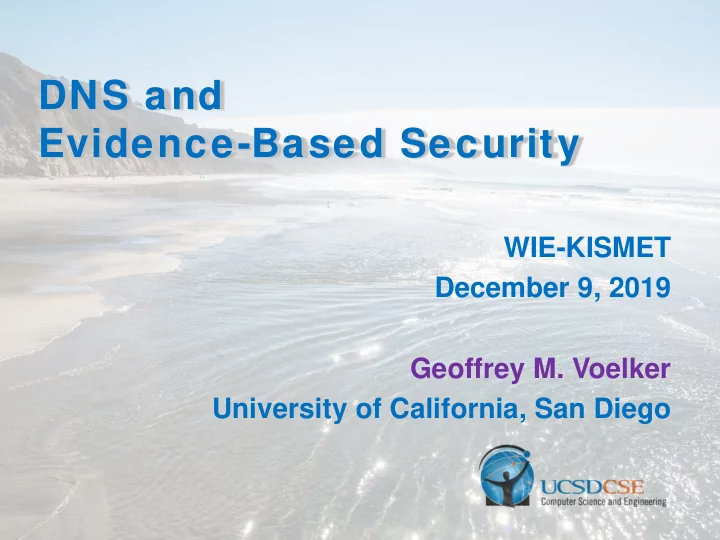

DNS and Evidence-Based Security WIE-KISMET December 9, 2019 Geoffrey M. Voelker University of California, San Diego
Evidence-Based Security • Our work in DNS and related areas has been motivated by long-term cybersecurity projects ♦ Wide variety of security projects over time ♦ DNS often plays a role since it is a fundamental resource • Our approach has been heavily measurement-based ♦ Effective intervention requires reasoning about motivations, incentives, requirements, communities 2
Impact of Domain Registration Policy Changes • Dec 2009: CCNIC policy changes induces 70x change in price of .cn domains • Effectively, a global sweeping change by a registrar • How did that influence spammers? Liu, Levchenko, Félegyházi, Kreibich, Maier, Voelker, Savage, On the Effects of Registrar-level I ntervention , LEET 2011 3
New Created Domains New Spam Advertised New Blacklisted 4
New Created Domains New Spam Advertised New Blacklisted 5
Impact of New TLDs • Explore impact of new TLDs on DNS • Do new TLDs serve their purpose (“meet unmet needs”)? • Approach ♦ Examine one new TLD in detail ♦ Expand to all new TLDs (circa 2014) 6
The .xxx TLD • Unusual TLD with storied history • Specialized TLD intended for adult content ♦ First proposed in 2000 by ICM Registry ♦ Debated for 10 years ♦ “…community will consist of the responsible global online adult-entertainment community” • Criticisms from many parties ♦ Trademark holders ♦ Adult entertainment industry (Free Speech Coalition) Halvorson, Levchenko, Savage, Voelker, XXXtortion? I nferring Registration I ntent in the .XXX TLD , WWW 2014 7
Content Categorization • Classified all .xxx domains by type of content served ♦ 193,363 domains in April 2013 • Web content ♦ Crawled all domains in zone file ♦ January 10, 2013 and April 12, 2013 ♦ Clustered using text shingling ♦ Generate labels using top clusters • WHOIS records ♦ For identifying registered non-resolving 8
Reserved Domains 9
Registered Non-Resolving • Registered but not in zone % dig ucsd.xxx NXDOMAIN • GoDaddy: “this is how to defend” • Use ICANN reports ♦ No exhaustive list ♦ Can infer numbers • Intent: Defensive 10
Summary • Does .xxx meet unmet needs? Absolutely not • Little benefit to intended demographic ♦ Whatever adult content is out there, it’s not in .xxx • Huge cost to everyone else ♦ Defensive registrations 93% of ongoing revenue ♦ To protect yourself, you have to register to prevent someone else from registering it for you 11
New gTLDs • Comprehensively identify all domains in new TLDs ♦ New TLDs up to 2015 ♦ Register for zone file access at ICANN ♦ Download over 500 zone files daily • DNS + Web crawl for content ♦ Every domain in a new TLD ♦ Millions from old TLDs (for reference) ♦ Web: 150GB visit, 1.5TB screenshots • Cluster + label downloaded content ♦ Bag of words, k-means, active learning Halvorson, Der, Foster, Savage, Saul, Voelker, From .academy to .zone: An Analysis of the New TLD Land Rush , I MC 2015 12
Content in Top TLDs 13
Registration Intent Registration Intent Result Primary 378,401 14.9% Defensive 1,005,109 39.5% Speculative 1,161,892 45.6% Primary registrations the lowest category 14
Registrar-level Attacks • Recently we have been interested in registrar attacks ♦ Registrar compromise, registrar account compromise, etc. • Attackers gain substantial leverage ♦ Shadow subdomains, DNS hijacking, etc. ♦ Motivated by attacks such as the 2014 Snecma.fr attack ♦ Particularly problematic since changes come from “owner” • Have been focusing on nameservers in particular ♦ Valuable targets, particularly useful for hijacking 15
Nameserver Abuse • Initially focused on suspicious nameserver activity ♦ Active crawls and passive zone files • But unusual behaviors can have benign explanations ♦ New NS added for 1-2 days that maps to an unusual /24? ♦ Sometimes highly suspicious…sometimes benign • Have been systematically categorizing nameserver dynamics to establish a “baseline” ♦ Consistency Misconfigurations, incomplete data, routing issues, etc. ♦ Diversity Topological concentration of NS’s and domains that use them ♦ Dynamics ♦ Joint with University of Twente, CAIDA, Ian Foster 16
Threat Intel • Threat Intelligence (TI) feeds distribute “indicators of compromise” for input into defenses ♦ IP addresses, file hashes, domain names, URLs ♦ Appearing on a feed indicates something “bad” • Using feeds now a standard operational practice ♦ Many feed sources, both public and commercial • How can a user evaluate the quality and utility of threat intelligence feeds? ♦ How do you choose which feed to use, or how many? ♦ How useful are they? (How do you define useful?) Li, Dunn, Pearce, McCoy, Voelker, Savage, Levchenko, Reading the Tea Leaves: A Comparative Analysis of Threat I ntelligence , USENI X Security 2019 17
Threat Intel Evaluation • Define six metrics for evaluation ♦ Volume, differential contribution, exclusive contribution, latency, accuracy, coverage • Define methods for calculating metrics across feeds ♦ Account for variations (e.g., snapshot vs event) • Examine 47 IP feeds and 8 malware hash feeds ♦ Dec 2017 – July 2018 ♦ Commercial and public feeds ♦ Categorized into six types: scan, brute force, malware, botnet, exploit, spam 18
Threat Intel Results • Significant issues across the metrics ♦ Coverage is poor when compared to ground truth data Scan feeds all combined only account for 2% of telescope scans ♦ Accuracy issues can lead to false positives Non-trivial amount of unroutable, top Alexa, CDN IPs ♦ Most IP indicators are singletons (very low intersection) ♦ Little evidence that larger feeds contain better data • Challenges ♦ Providers do not explain how data is collected and labelled Left to users to decide how to interpret ♦ Little insight into operational uses of feeds 19
Recommend
More recommend